Jensen & Skodvin Arkitektkontor
Gudbrandsjuvet
Gudbrandsjuvet is a five metre wide and 20‒25 metre long gorge, through which the Valldøla river runs.
- Architect:
- Jensen & Skodvin Arkitektkontor
- Finished:
- 2010
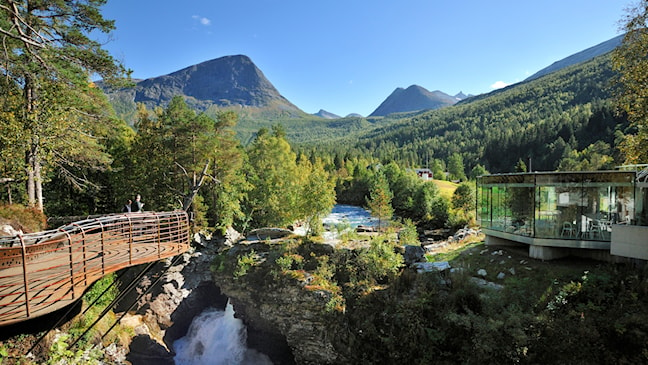
The gorge is easily accessible near National Road 63 between Valldal and Trollstigen. Here, Jan Olav Jensen has designed a functional and safe viewing platform with ample space. A unique bridge has been built from the car park down to the viewing platform, leading visitors down to the gorge. The gradient of the bridge is designed for accessibility for wheelchair users. In cooperation with the architect, Civil Engineer Finn Erik Nilsen has challenged the laws of physics to create an 80 metre long hybrid of a suspension bridge and a rigid frame. The Gudbrandsjuvet Café is built of durable materials, such as glass and concrete. Within walking distance of the gorge you can find the Juvet Landscape Hotel, also designed by Jensen & Skodvin, which is well worth a visit.
Havøysund Artwork
Untitled
- Artist:
- Roni Horn
- Architect:
- Jensen & Skodvin Arkitektkontor
- Finished:
- 2021

Untitled (“I hated the mountains and the hills, the rivers and the rain. I hated the sunsets of whatever colour, I hated its beauty and its magic and the secret I would never know. I hated its indifference and the cruelty which was part of its loveliness.”)
American artist Roni Horn is based in New York and is one of the most sought-after artists of our time. Her work is exhibited in art galleries and museums around the world. The artist has created two large glass objects, each of 4.9 tonnes, with a height of 133 cm and a diameter of 142 cm. One has a cool bluish colour; the other is warm peach.
Their massiveness and volume are striking. The objects exude silence in a weather-beaten and beautiful corner of the world, where the variations of light - midnight sun, northern lights and winter darkness - are constantly creating new moods.
The idea of the Norwegian Scenic Routes to establish a work of art in Havøysund is linked to the fact that this is where the road ends. The road out here invites you to experience the magnificent landscape. To continue from here, you would have to go by boat. Roni Horn’s art invites visitors to continue their journey in their imagination.
(Quote in the title: from Wide Sargasso Sea by Jean Rhys, 1966).
Artist: Roni Horn
Completed 2013 - 2015
Liasanden
Liasanden in the Leirdalen valley, Lom municipality, has been a popular rest area for ages.
- Architect:
- Jensen & Skodvin Arkitektkontor
- Finished:
- 1997 / 2024

At Liasand, the architects saw that it was possible to create a different and idyllic rest area in the pine forest. Here the trees and the terrain have been allowed to determine the design of the rest area, right down to the smallest detail. The gravel road is shaped like a "river", widening and narrowing in interaction with the terrain.
Concrete furniture was placed inside the pine forest, and in combination with a toilet and an information stand in wood and concrete, the rest area became a complete and functional facility for road travellers.
The rest area has been popular since it was opened in 1997 and thus subject to many visitors and camping, wearing it down and causing damage to roots and undergrowth.
After having been closed for a couple of years, Liasanden is reopening in June 2024, with upgraded toilets, new outdoor areas with seating, and improved facilities for cyclists in the form of two cyclists’ shelters.
As an environmental protection measure, the Norwegian Public Roads Administration has closed the forest to car traffic, referring travellers to the communal parking on the east side, from where they can easily walk into the recreation area.
Year of construction 1996-97
Builder and contractor: The Norwegian Public Roads Administration
Architect: Jensen & Skodvin architects
Year of construction 2022-24
Builder and contractor: The Norwegian Public Roads Administration
Architect: Jensen & Skodvin architects
Contractor for renewal and restoration: Mesta AS
Mefjellet
At the rest area at Mefjellet you can experience both the majestic view over the mountains and the art of Knut Wold.
- Architect:
- Jensen & Skodvin Arkitektkontor
- Artist:
- Knut Wold
- Finished:
- 1997
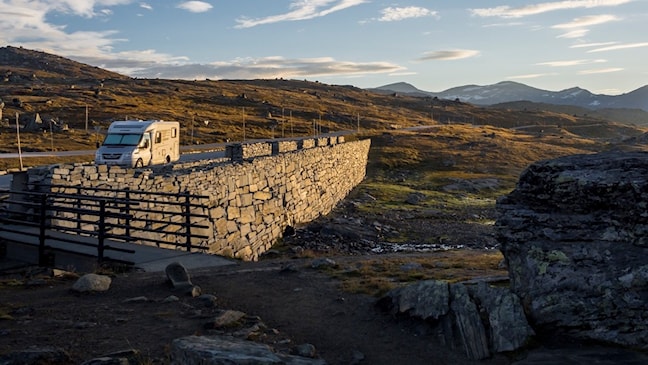
The rest area was created in collaboration with the architect Jan Olav Jensen and was the first point to be developed on the Norwegian Scenic Routes. The idea was to make the rest area into a large “nature gallery” to reinforce the panoramic view and the feeling of loftiness. The rest area at Mefjellet was designed as a terrace with natural stone walls. We placed a “cubist” stone sculpture of larvikite out on the plateau wich frames the Smørstabb pinnacles and the grandeur of the surrounding landscape.
Knut Wold is a Norwegian sculptor living in Stange. He studied at Alanus Hochschule der Kunste and Hochschule der Kunste, Berlin. Wold frequently works with objects in large masses of only partially worked stone.
Oscarshaug
The toilet at this place has been given a new solid steel superstructure.
- Architect:
- Jensen & Skodvin Arkitektkontor
- Finished:
- 2020

From the parking area there is a well-maintained path up to the cairn at the top of Oscarshaug. The path has a simple steel railing. The area has room for two buses, five motorhomes and 20 passenger cars.
Øvstefoss
The Øvstefoss waterfall lies at the end of the Hjelledalen valley, just below the crossing with the Gamle Strynefjellsvegen.
- Architect:
- Jensen & Skodvin Arkitektkontor
- Finished:
- 2010
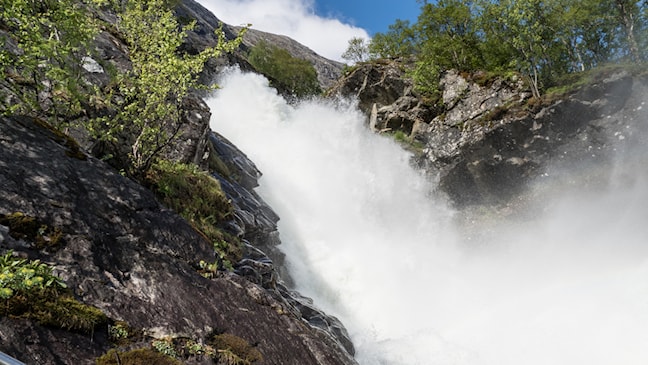
Together with Hjelle and the Jøl bridge, the waterfall offers an interesting rest area that previously belonged to the original Strynefjell road, before tunnels ensured year-round traffic between east and west. For more than 100 years, the Øvstefoss waterfall has amazed travellers crossing the Strynefjell mountains. In 1997, the Norwegian Public Roads Administration opened an information site devoted to the Norwegian Scenic Routes and designed by Jensen & Skodvin at Øvstefoss. For many years, the safety of the path leading down along the waterfall remained questionable, but since 2010 visitors can tread safely. Steel railings, approximately 200 metres in length, have been mounted as an extension of the information site. The railings ensure that visitors can safely enjoy a first-hand experience of the swirling waterfall.
Ropeid
- Architect:
- Jensen & Skodvin Arkitektkontor
- Architect:
- KAP - Kontor for Arkitektur og Plan
- Finished:
- 2004 og 2021
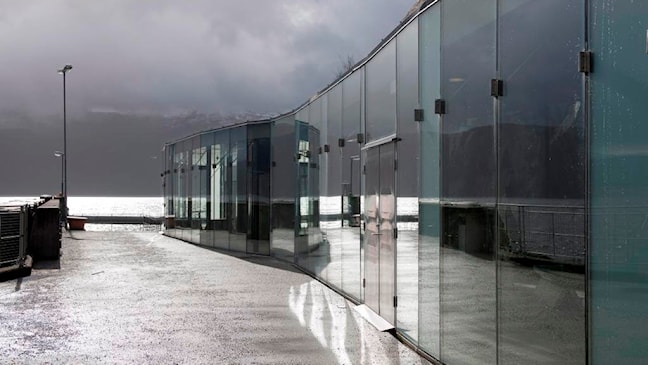
The new Sandsfjord Bridge replaced the ferry between Sand and Ropeid, thus reducing ferry activity as well as land use. The quay was left unused with large asphalt surfaces and rough rock materials down by the sea.
The idea behind the new rest area was to repair the landscape. The rest area is designed as a reconstruction of the original landscape form; the islet was dug free and contact with the sea restored. The broken sea line was “bandaged” with concrete mattresses made with textile formwork, now forming artificial seaside rocks.
In the holes of the mattress, grass has been sown that will form a set pattern.
The mattress landscape contains furniture elements such as seats and tables, lanterns and lamps. The furniture forms mushroom-like structures in small clusters. They are made of materials from recycled plastic boats from Ryfylke.
According to the architect, the project is an approach to the landscape that blurs the distinction between culture and nature. The artificial imitates nature and the natural imitates the artificial.
Architect: KAP arkitekter
Completed 2021
The name Ropeid is believed to originate from the old days, when news from both sides, Suldal and Vindafjord respectively, was communicated by shouting - in Norwegian “rope” - across the fiord.
In 2004, when ferries were still in operation at Ropeid, the Norwegian Public Roads Administration completed a waiting room with toilets on the quay. The building has large glass surfaces that create a proximity to the fiord and the landscape, and a bare rough rock surface forms the inner wall. The beautiful waiting room is now in use as an open library and a venue for other cultural events.
Architect: Jensen & Skodvin Architects
Completed 2004
Sognefjellshytta
An exterior of wood and glass disperses the light entering the room, thus communicating the varied ambience of light and weather in the high mountains.
- Architect:
- Jensen & Skodvin Arkitektkontor
- Finished:
- 2014
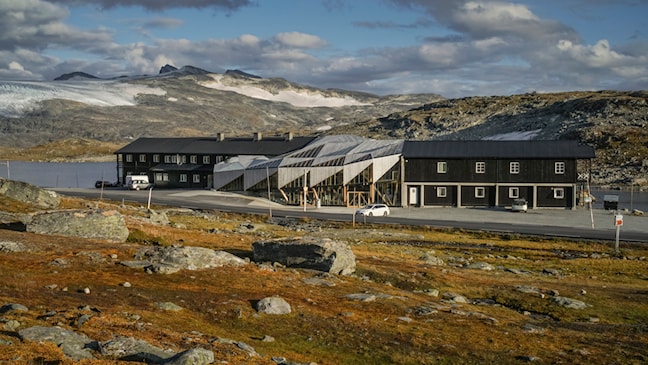
The Sognefjell Lodge has been refurbished with a new and characteristic interior, including a more functional entrance area, a larger reception and universal accessibility. The new addition is constructed in latticework patterned in triangles that mirror the existing gables on each side. An exterior of wood and glass disperses the light entering the room, thus communicating the varied ambience of light and weather in the high mountains.
Videfossen
This waterfall has been an attraction ever since tourists started to cross the mountain a long time ago.
- Architect:
- Jensen & Skodvin Arkitektkontor
- Finished:
- 1997
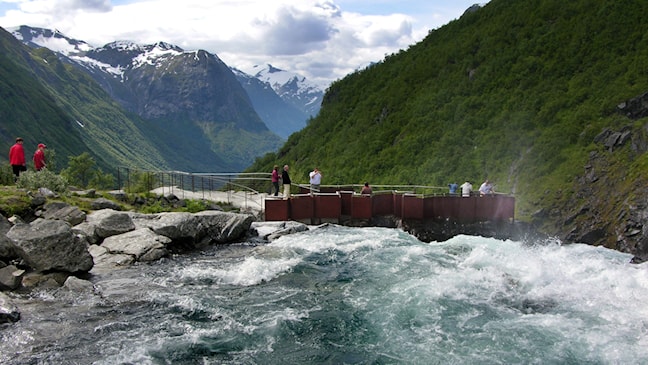
At some point, it was provided with a minimum of safety in the form of poles and wire mesh. When the Norwegian Public Roads Administration started its work on the route in 1994, the site was in a dire state of disrepair. In addition, the location is occasionally exposed to avalanches. The initial idea was to remove the railing and leave the waterfall as an immediate and natural experience. However, removal of the safety installations would have involved a considerable responsibility. The architect contacted avalanche experts and chose a solution that would stop avalanches but leave the view unobstructed. The steel plates were point-welded to permit them to give way under extreme loads. At the same time, the plates act as snow barriers during especially snowy winters, and direct any avalanches over and above the facility. Improvements at Videfossen also included construction of a new walkway with railings leading to the vantage point.